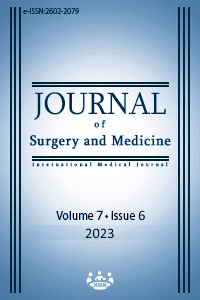Comparison the effects of sugammadex and neostigmine/atropine on cognitive functions in bariatric surgery patents: Randomized controlled trial
The effects of sugammadex on cognitive functions in bariatric surgery
Keywords:
sugammadex, neostigmine, atropine, cognitive dysfunction, bariatric surgeryAbstract
Background/Aim: A recently introduced drug, sugammadex, can be a good alternative to conventional neuromuscular blockade reversal agents, such as neostigmine. This choice is of great importance, especially in the patients in whom it would be wise to avoid cholinergic side effects. The aim of this study was to compare the effects of sugammadex and the combination of neostigmine/atropine on post-operative cognitive dysfunction in bariatric surgery patients.
Methods: This randomized controlled trial included a total of 90 patients with American Society of Anesthesiologists (ASA) I–III physical status and body mass index >30 who were scheduled for elective sleeve gastrectomy were recruited for the study after obtaining ethics committee approval. Written consent was obtained from each patient. The exclusion criteria consisted of several parameters: lack of consent, co-existing muscular diseases, and severe cardiovascular diseases (New York Heart Association [NYHA]). The patients were randomly divided into two groups, and the randomization was performed by the investigator using previously prepared envelopes. In both groups, Mini Mental State Examination (MMSE) was performed before the operation. The patients’ memory, attentive executive functions, and motor skills were evaluated as part of a control cognitive evaluation. After the operation while in the post-anesthesia care unit and when the Modified Aldrete Recovery Score was ≥9, the MMSE evaluation was repeated one and six hours later.
Results: The pre-operative MMSE results were similar in both groups. In the post-operative period, MMSEpo, MMSEpo1, and MMSEpo6 values were not significantly different between the groups. When a detailed examination of MMSEpo data was performed, it was determined that the MMSE scores were 20–25 in 14 patients (32.6%) in Group N/A and six patients (14.6%) in Group S. In Group N/A, the percentage of patients with MMSE 20–25 was significantly higher than that of Group S (X2=3.807; P=0.046).
Conclusion: In this study, sugammadex produced less effects on cognitive functions when compared with neostigmine/atropine combination. The neostigmine/atropine combination produced mild effects on cognitive functions in the first hour of recovery.
Downloads
References
Plaud B, Debaene B, Donati F, Marty J. Residual paralysis after emergence from anesthesia. Anesthesiology 2010 April;112(4):1013-22. DOI: https://doi.org/10.1097/ALN.0b013e3181cded07
Farrar JT, Meeting of the Anesthetic and Life Support Drugs FDA Advisory Committee, Silver Spring, MD. Sugammadex. 2008:222-5.
Fuchs-Buder T, Meistelman C, Raft J. Sugammadex: clinical development and practical use Korean J Anesthesiol. 2013 Dec;65(6):495-500. DOI: https://doi.org/10.4097/kjae.2013.65.6.495
Butterworth JF, Mackey DC, Wasnick JD. Morgan and Mikhail’s Clinical Anesthesiology 5th edition, section 2, Clinical Pharmacology, Chapter 12, Cholinesterase Inhibitors and Other Pharmacological Antagonists to Noromuscular Blocking Agents, p 223-33.
Gaszynski T, Szewczyk T, Gaszynski W. Randomized comparison of sugammadex and neostigmine for reversal of rocuronium-induced muscle relaxation in morbidly obese undergoing general anaesthesia. Br J Anaesth. 2012 Feb;108(2):236-9. DOI: https://doi.org/10.1093/bja/aer330
Butterworth JF, Mackey DC, Wasnick JD. Morgan and Mikhail’s Clinical Anesthesiology 5th edition, section 2, Clinical Pharmacology, Chapter 13, Anticholinergic Drugs, p 233-9.
Ward B, Imarengiaye C, Peirovy J, Chung F. Cognitive function is minimally impaired after ambulatory surgery. Canadian Journal of Anesthesia. 2005 Dec;52(10):1017-21. DOI: https://doi.org/10.1007/BF03021598
Selwood A, Orrell M. Long term cognitive dysfunction in older people after non-cardiac surgery. BMJ. 2004 January;328:120–1. DOI: https://doi.org/10.1136/bmj.328.7432.120
Wu CL, Hsu W, Richman JM, Raja SN. Postoperative cognitive function as an outcome of regional anesthesia and analgesia. Regional Anesthesia & Pain Medicine. 2004;29(3):257-68. DOI: https://doi.org/10.1097/00115550-200405000-00013
Dodds C, Allison J. Postoperatif cognitive deficit in the elderly surgical patients. Br J Anaesth. 1998 September;81(3):449–62. DOI: https://doi.org/10.1093/bja/81.3.449
Işık B. Anestezinin kognitif fonksiyonlarla ilişkisi. T Klin J Anest Reanim. 2004;2:94–102.
Tombaugh TN, McIntyre NJ. The mini‐mental state examination: a comprehensive review. J Am Geriatr Soc. 1992 September;40(9):922-35. DOI: https://doi.org/10.1111/j.1532-5415.1992.tb01992.x
Batistaki C, Riga M, Zafeiropoulou F, Lyrakos G, Kostopanagiotou G, Matsota P. Effect of sugammadex versus neostigmine/atropine combination on postoperative cognitive dysfunction after elective surgery. Anaesth Intensive Care. 2017 September;45(5):581-8. DOI: https://doi.org/10.1177/0310057X1704500508
Kölükçü E, Parlaktaş BS, Kölükçü V, Sarıkaya K, Senocak S, Bozkurt OF. Our experience of laser lithotripsy under local anesthesia in the treatment of bladder stones in obese male patients. Journal of Health Sciences and Medicine. 2016;4(3):314-21. DOI: https://doi.org/10.32322/jhsm.902684
Tüzüner Filiz, Alkış Neslihan, Aşık İbrahim, Yılmaz Ali Abbas. Anestezi Yoğun Bakım Ağrı. MN Medikal & Nobel 2010;1087-120.
Deiner S, Silverstein JH. Postoperative delirium and cognitive dysfunction. Br J Anaesth. 2009 December;103(suppl_1):41–6. DOI: https://doi.org/10.1093/bja/aep291
Breslin DS, Reid JE, Mirakhur RK, Hayes AH, Mc Brien ME. Sevoflurane-Nitrous Oxide Anaesthesia Supplemented With Remifentanil: Effect On Recovery And Cognitive Function. Anaesthesia. 2001 August;56(2):114-9. DOI: https://doi.org/10.1046/j.1365-2044.2001.01795.x
Chen G, Zhou Y, Shi Q, Zhou H. Comparison of early recovery and cognitive function after desflurane and sevoflurane anaesthesia in elderly patients: A meta-analysis of randomized controlled trials. J Int Med Res. 2015;43(5):619-28. DOI: https://doi.org/10.1177/0300060515591064
Brown DV, Heller F, Barkin R. Anticholinergic syndrome after anesthesia: a case report and review. Am J Ther 2004 March;11(2):144-53. DOI: https://doi.org/10.1097/00045391-200403000-00010
Schneck HJ, Rupreht J. Central anticholinergic syndrome (CAS) in anesthesia and intensive care. Acta Anaesthesiol Belg. 1989 January;40(3):219-28.
Pişkin O, Kucukkosman G, Altun DU, Çimencan M, Ozen B, Aydın BG, et al. The effect of sugammadex on postoperative cognitive function and recovery. Brazilian Journal of Anesthesiology. 2016 Jul-Aug;66(04):376-82. DOI: https://doi.org/10.1016/j.bjane.2014.10.003
Downloads
- 494 859
Published
Issue
Section
How to Cite
License
Copyright (c) 2023 Ülkü Sabuncu, Hatice Selçuk Kuşderci , Mesut Öterkuş , Ruslan Abdullayev , Öznur Uludağ , Sabri Özdaş
This work is licensed under a Creative Commons Attribution-NonCommercial-NoDerivatives 4.0 International License.
















